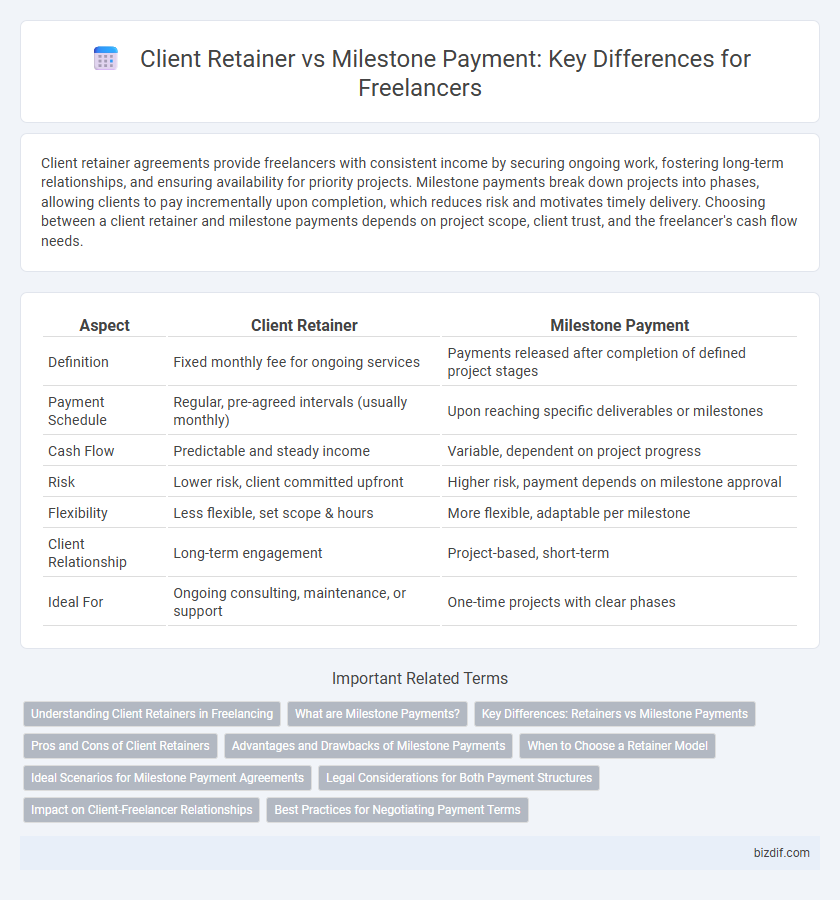Client retainer agreements provide freelancers with consistent income by securing ongoing work, fostering long-term relationships, and ensuring availability for priority projects. Milestone payments break down projects into phases, allowing clients to pay incrementally upon completion, which reduces risk and motivates timely delivery. Choosing between a client retainer and milestone payments depends on project scope, client trust, and the freelancer's cash flow needs.
Table of Comparison
| Aspect | Client Retainer | Milestone Payment |
|---|---|---|
| Definition | Fixed monthly fee for ongoing services | Payments released after completion of defined project stages |
| Payment Schedule | Regular, pre-agreed intervals (usually monthly) | Upon reaching specific deliverables or milestones |
| Cash Flow | Predictable and steady income | Variable, dependent on project progress |
| Risk | Lower risk, client committed upfront | Higher risk, payment depends on milestone approval |
| Flexibility | Less flexible, set scope & hours | More flexible, adaptable per milestone |
| Client Relationship | Long-term engagement | Project-based, short-term |
| Ideal For | Ongoing consulting, maintenance, or support | One-time projects with clear phases |
Understanding Client Retainers in Freelancing
Client retainers in freelancing provide a consistent revenue stream by securing ongoing work through a prepaid monthly or periodic fee, ensuring priority access to the freelancer's services. Unlike milestone payments that are tied to specific project deliverables, retainers focus on maintaining a long-term working relationship and steady workload. This arrangement enhances financial stability for freelancers while offering clients flexibility and guaranteed availability for continuous support or consultation.
What are Milestone Payments?
Milestone payments are a method of breaking down a freelance project into smaller, manageable segments, where clients release funds upon the successful completion of specific deliverables. This payment structure ensures clear accountability and progress tracking, providing security for both freelancers and clients by aligning payments with project advancements. Milestone payments help mitigate risk, improve cash flow, and foster transparent communication throughout the freelance engagement.
Key Differences: Retainers vs Milestone Payments
Client retainers guarantee ongoing freelance services through a fixed monthly or periodic fee, ensuring steady income and priority availability. Milestone payments break down the project into specific deliverables or phases, releasing funds only upon successful completion of each stage. Retainers emphasize long-term commitment and predictability, while milestone payments focus on performance and progress-based compensation.
Pros and Cons of Client Retainers
Client retainers provide freelancers with consistent cash flow, ensuring financial stability and long-term client relationships while enabling prioritized project scheduling. However, retainers may limit flexibility, requiring commitment regardless of workload fluctuations and can complicate scope management if expectations are not clearly defined. Balancing clear communication and detailed agreements helps maximize the benefits of client retainers in freelancing.
Advantages and Drawbacks of Milestone Payments
Milestone payments in freelancing offer clear advantages, including improved cash flow management and segmented project delivery, which helps clients assess progress and freelancers receive timely compensation. However, drawbacks include potential delays if milestones are not well-defined, and increased administrative effort to manage multiple payments. This system may also lead to fragmented focus, impacting the overall quality and timeline of the project.
When to Choose a Retainer Model
Choose a client retainer model when ongoing work requires consistent availability and priority access to your services, such as in long-term projects or advisory roles. Retainers provide financial stability and foster stronger client relationships by ensuring continuous collaboration and streamlined communication. This model is ideal for freelancers offering consultancy, maintenance, or strategic support where deliverables are less defined but continuous input adds significant value.
Ideal Scenarios for Milestone Payment Agreements
Milestone payment agreements are ideal for complex projects requiring staged deliverables, ensuring both clients and freelancers maintain clear expectations and accountability. This approach suits scenarios where project scope may evolve, enabling iterative feedback and adjustments while safeguarding payment security at each phase. Freelancers benefit from steady cash flow and risk reduction, while clients gain confidence through measurable progress before releasing funds.
Legal Considerations for Both Payment Structures
Client retainers offer consistent cash flow and ongoing work commitments but require clear contractual terms defining scope, duration, and termination to avoid disputes. Milestone payments protect both parties by tying compensation to specific deliverables, necessitating detailed agreements outlining milestones, deadlines, and consequences for missed targets. Ensuring compliance with local contract laws and including clauses on dispute resolution and intellectual property rights is essential for legally sound freelancing payment structures.
Impact on Client-Freelancer Relationships
Client retainers foster long-term trust and ongoing collaboration by ensuring consistent payment and priority access to the freelancer's services, which strengthens the client-freelancer relationship. Milestone payments provide clear project benchmarks and incentivize timely delivery but can create transactional interactions that limit relationship depth. Choosing retainers or milestones impacts communication frequency, project commitment, and mutual confidence between clients and freelancers.
Best Practices for Negotiating Payment Terms
Establish clear client retainer agreements to secure consistent cash flow and demonstrate commitment, specifying scope, payment schedule, and cancellation terms. Define milestone payments with precise deliverables and deadlines to maintain transparency and motivate timely project progress. Utilize contracts that balance flexibility and protection, ensuring mutually agreed upon terms minimize disputes and foster long-term client relationships.
Client Retainer vs Milestone Payment Infographic

 bizdif.com
bizdif.com